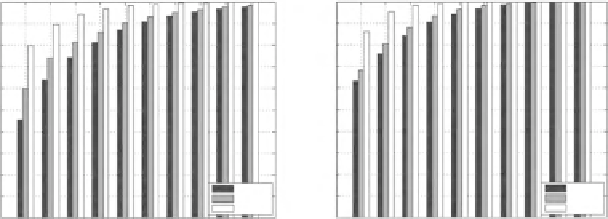Geoscience Reference
In-Depth Information
Model Fit to Data Values
Model Fit to Data Values
100
90
80
70
60
50
40
30
20
10
0
100
90
80
70
60
50
40
30
20
10
0
Free - Run
First Guess
4D-Var
Free-Run
First Guess
4D-Var
123456789 0
123456789 0
Data Standard Deviations
Data Standard Deviations
Fig. 15.9
Cumulative bar chart showing the percentage of the number of observations that are
matched by the free running model (
black
), the first guess (
grey
) and the analysis (
white
)asa
function of the number of observation standard deviations. MODAS experiment is shown on the
left
and AOSN II experiment on the
right
the corresponding numbers for the first guess are 68 % and 80 %, and 64 % and 76
% for the free running model.
The large posterior misfits happened for some temperature observations with
prior misfits sometimes higher than
5
ı
, and the assimilation reduces these misfits
to about
1:5
ı
. They are larger than 7 standard deviations primarily because of very
low data errors and possibly high model errors. It is assumed that a better fit would
be achieved with larger observation errors and lower model errors. Such experiments
(not shown here) are carried in the context of real observations and are the subject
of another study.
15.5
Conclusion
A 4D-Var assimilation system for NCOM has been developed based on the indirect
representer method. The system produces analysis increments for all prognostic
variables (3D temperature, salinity, u- and v- components of velocity, and sea
surface elevation) from a time-window of observations in a weak-constraint envi-
ronment. The adjoint model has been checked against the linearized model using
well established methods, verifying that the system is symmetric to within machine
precision. Assimilation experiments were carried out with two different data sets.
The first experiment involved MODAS synthetic data (
,
SSH
) that were sam-
pled every 6 h and assimilated in a sequence of 5-day time windows. Starting from
an initial condition on August 02, the model was integrated and the assimilation
performed for 5 days at a time, with the analysis at the end of the 5 days becoming
the initial condition for the following 5-day assimilation. The results indicate that the
assimilation system is performing correctly, with the model-data misfit is reduced
substantially as examined at individual profiles.
T
,
S

Search WWH ::

Custom Search